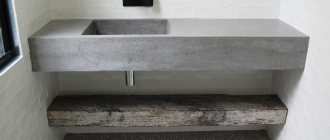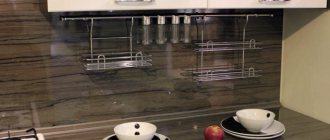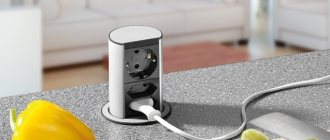One of the main bathroom accessories is the washbasin. Washbasin models may differ not only in design and design, but also in the installation method, although installing a washbasin with your own hands is quite possible for anyone. Of course, first of all, it is important to acquire some knowledge and skills that will help in complying with the technology.
Before installing a washbasin, you need to consider which models are available on the modern market.
Siphon
The simplest siphon is an S-shaped bend of a corrugated outlet hose, rotated 90 degrees in a vertical plane. For the washbasin, in theory, it is quite enough: used toilet paper, sanitary pads and scraps from dishes do not end up in the sink.
Elite washbasin with decorative siphon
However, there is a “but” - when cleaning a sewer with a plunger, the corrugation plays a lot and breaks over time, and when cleaning with a pneumatic plunger (powered by a can of compressed inert gas), it often breaks immediately. Corrugations cannot be cleaned with a cable at all. Therefore, if the sewage system in the apartment is unimportant and you have to “break through” it often, you need a rigid siphon with an inspection (removable lid for inspection and cleaning), and in the kitchen it is absolutely necessary.
There are two types of rigid siphons: an elbow with a removable hatch (obsolete) and a bottle siphon. The last one is two concentric pipes, of larger and smaller diameter. The smaller one is inserted into the larger one with a gap at the bottom. The bottom cover of the bottle siphon is a threaded hatch; outlet - on the side.
Cleaning the bottle is simple: put on gloves, place a bucket, unscrew the bottom hatch and all the “bad stuff” plops into the bucket. You just need to make sure when purchasing that the outer pipe has some narrowing towards the top, otherwise the dirt may get stuck and you will have to pick it out.
The pinnacle of the evolution of siphons and at the same time tulip washbasins (see below) is a decorative chrome siphon with revision (see picture on the right). Among other things, it is also absolutely hygienic and functional. But the cost is an order of magnitude higher than usual, the sewerage installation for it is only built into the walls, which is also not cheap, and installation requires professional work.
Installation of the siphon with revision is always carried out before hanging the sink; corrugated siphon - whatever is more convenient for the location. In both cases, a transition collar is required from 32 mm (diameter of the sink outlet) to the existing diameter of the sewer pipes, from 40 to 100 mm; you need to look locally.
More in-depth details of choosing and installing a siphon are described in the link.
Mixer and fittings
The best mixer is one with a ball valve and a swing lever. When purchasing it, you need to make sure that the faceted parts of the threaded fittings of the flexible supply pipes - henok - are located at different levels, otherwise during installation they will not fit on the mixer pipes. This problem does not arise in a mixer with separate taps.
Henks are more durable and reliable than metal-plastic ones, but installing a mixer with them is only possible in an already suspended sink, which is inconvenient. Plastic henki in a woven fabric shell can be pulled out through the opening under the sink and attached without bending over and in the light, but they sometimes tear.
Sink in the cabinet
How to properly install a faucet on a sink or sink - read further here.
Connecting the washbasin to the sewer and water supply system ↑
Connection to the sewer can be made using either corrugated hoses or rigid plastic or metal pipes. It is necessary to have rubber seals - these can be standard seals for sewer pipes or special cuffs for corrugations.
Connection to the water supply is carried out using special flexible hoses, the ends of which have union nuts. First, the presence of gaskets on the nuts is checked, then the hoses are connected to instrument taps, pre-installed on the pipes that supply water. Next, the nuts are tightened tightly and tightened with a wrench.
Connection diagram of the washbasin to the water supply
No matter how simple the process of installing a vanity may seem, you will need some skills and knowledge. Poor installation can lead to all sorts of problems, so seek advice from a professional plumber before you begin.
Connection diagram of the washbasin to the sewer
Installation of a washbasin
Installation of the sink in the bathroom is carried out by hanging it from the wall using standard brackets and self-tapping screws in dowels. Remember that even a complete pedestal, from the bottom of the sink to the floor, is not a load-bearing part! Self-tapping screws must enter the body of the wall at least 70 mm, so we take them at least 100 mm long if the wall has plaster under the tiles, and even longer for thicker coatings.
Dowels are propylene. Polyethylene is fragile, metal rusts, PVC cracks due to changes in temperature and humidity.
The diameter of the screws is the maximum possible that the brackets allow. Remember that the sink of any washbasin is suspended, and the lever, even with light pressure on its edge, becomes powerful. If the diameter of the holes for the screws turns out to be less than 6 mm, then they need to be drilled out, or not to take such a sink at all, especially since such “alternative” products most often turn out to be silumin (very fragile) or plastic, fragile.
Sometimes a sink with a cabinet is installed in bathrooms (see top picture). But it requires a spacious bathroom, dirt can accumulate under the cabinet and inside it, and the capacity of a solid-looking dressing table is actually small: a siphon with pipes takes up a lot of space, so this solution is more of a tribute to tradition.
Video: installing a wall-hung sink
Bracket mounting technology
Today, brackets are considered the most popular method of installing a sink. Let's consider the technology of such installation.
Brackets
Stage 1. Draw a line parallel to the floor surface at a height of about 80 centimeters. This is the base mark from which you will make further calculations. It is at this height that sinks are often installed.
Stage 2. Using a tape measure, measure the thickness of the sink wall that will be adjacent to the wall surface. The resulting figure is the distance that needs to be measured from the base line down and draw another line there. This is where the brackets will be attached. Measure the distance between the brackets and mark their position on the line. The resulting marking is projected onto the base line on the wall.
You may be interested in information about installing a heated towel rail
Stage 3. Place the brackets on the base line, mark where they will be attached and drill holes there. Insert dowels into the holes and secure the brackets to the wall.
Brackets are attached
Stage 4. The sink is attached to the installed brackets according to the supplied manufacturer's instructions.
Sink installation
As we see, there is nothing complicated here if you have all the necessary tools and a natural “eye.” Now all you have to do is connect the remaining elements - the mixer and the siphon, but we will talk about this later.
You may be interested in information: Hydrogenation
Sink installation
Installing a kitchen sink in terms of strength is easier because it has a reliable support in the form of a countertop. An exception is a sink with sinks under the countertop, see below, but these are practically not found in everyday life and require highly professional work for installation.
But technologically, a kitchen sink is more difficult, since you have to work inside the kitchen furniture, bent over, in the dark, and you need to do carpentry. Accordingly, hired craftsmen charge quite a lot for such work. Therefore, if you are accustomed to tinkering, it makes sense to install the sink in the kitchen yourself. We will touch on the specifics of installing different types of sinks below.
Semi-pedestal washbasin
This type of washbasin is similar to the tulip washbasin, although there are some differences. In some cases, the semi-pedestal plays the role of decoration. The washbasin bowl itself should be attached to the wall. To do this, mark where to drill the holes (the principle of installing a washbasin on brackets works here). It is imperative to install rubber gaskets in places where the dowel may come into contact with the sink. This is necessary in order to avoid cracks in the bowl. After installation, the siphon and mixer are installed, and then the semi-pedestal.
Sealing
All modern plumbing fixtures are equipped with standard gaskets. When working with them, the following rules should be observed:
- All sealing work must be carried out only on completely dry fittings. You can dry it with a household hairdryer if necessary.
- If possible, avoid touching mating surfaces with your hands. If captured, degrease them by rinsing them in water and household dishwashing detergent.
- Place paronite (red or yellow, hard) gaskets between the plastic parts and the metal supply pipe.
- Plastic pipes of standard fittings are supplied with a reserve; they need to be cut to size, but in the absence of much experience - only with a plastic pipe cutter. The slightest distortion of even the smoothest cut - and the joint will leak, even if it cracks.
- Lubricate rubber gaskets with silicone sealant before installation.
The latter requires some explanation. Separately, rubber and silicone last for several years, but together they are surprisingly durable. As it turned out, the point is the difference in their coefficients of thermal expansion: the materials all the time seem to knead each other, preventing them from hardening tightly and cracking. If the plumbing installation was carried out taking into account the above, you won’t have to think about leaks for many years.
Sink installation height
The installation height of the sink is not strictly regulated by any regulatory documents. SNiP give recommendations of 80-85 cm, but this is based on average height data. Scandinavian construction sites recommend 85-90 cm, and in Trondheim, the homeland of the Viking giants, even 90-95 cm. In Ecuador and Colombia, where most of the population are short Indians and mestizos, they recommend, on the contrary, 75-80 cm.
So do what is most convenient - in a small family you can hang it lower; in the Bogatyrskaya - higher. True, if you plan to install a washbasin with a pedestal, you will have to be tied to its height.
Removing an old sink
The first stage of work will be removing the old sink.
Important! Before starting the dismantling procedure, be sure to turn off the water.
First, unscrew the nuts that secure the mixer. Then disconnect the liner and remove the mixer. Remove the siphon connecting the sink to the sewer system - unscrew the nuts (they are located at the bottom), remove the siphon itself and pour the water out of it. If you plan to replace it with a new one, then disconnect it from the drain and then temporarily plug the hole with something (a rag, for example) so that unpleasant odors do not penetrate into the apartment. Finally, remove the sink from its mountings.
You might be interested in information on how to install a sink
Types of shells and their features
The usual wall-hung sink is familiar to everyone, so let’s move straight to more modern varieties.
Tulip
Semi-pedestal sinks
The tulip washbasin first appeared in railway carriages and exists there in its original form to this day. Its distinctive feature is not a pedestal at all, but a narrow, deep sink. It had to be deepened to reduce splashing.
In the small bathrooms of apartments built in the post-war years, this design was just right, and for aesthetics (the siphon was in plain sight), the tulip sink was equipped with a pedestal. Appearing en masse in bombed-out England and Germany, the innovation spread widely throughout the world, and soon all the shells on the pedestal began to be called tulips, although they already looked no more like a tulip than a dahlia or odontoglossum orchid.
Long-term and extensive practice has shown that the tulip, in general, did not justify itself, primarily from a sanitary and hygienic point of view. The cavity in the pedestal is a favorite habitat of small domestic animals, and under a microscope, smears from the floor along the perimeter of the pedestal can make even a seasoned sanitary doctor's face stretch out.
Half tulip
Modern sanitation and hygiene are based on the fact that the floor in the bathroom and toilet should be as free and accessible for cleaning as possible. Any, even the smallest nook, becomes a source of infection, so tulip sinks have recently been replaced by sinks with a half-pedestal - half tulips (see figure), no less aesthetic, but not cluttering up the floor.
Half-tulips have one drawback: to clean the siphon, you have to remove either the entire shell (in the picture below) or its rather heavy and fragile part in the air, risking dropping it and breaking it (in the picture above). But the washbasin siphon gets clogged extremely rarely, so this drawback is very relative. It is completely eliminated in sinks with a decorative siphon-semi-pedestal, which are mentioned above.
Sink above the washing machine
Sink over washing machine
The washbasin above the washing machine (see picture on the right) is a relatively recent innovation and, I must say, it was invented perfectly. Everything ingenious is simple - for centuries no one even guessed that it was quite possible to place the grille of a washbasin behind the bowl or in its far corner.
For residents of small apartments, this solution is just a godsend. Unfortunately, the price of this popular product is still disproportionately high. But you can make a plastic sink yourself, and select a mixer with a siphon separately.
An approximate installation diagram for such a sink is shown in the following figure. A siphon for such a sink requires a bottle siphon, with an additional pipe for connecting the washing machine drain.
Installation diagram of a sink above a washing machine
Double sink
The double or two-cup sink first appeared as an attribute of luxury apartments with a spacious bathroom. But manufacturers soon realized that a double washbasin, to paraphrase Ostap Bender, is not a luxury, but a means of hygiene: most of all, it is needed in a working family living on a salary. Here, the price of minutes of morning toilet on a working day is higher than some hustle and bustle in the bathroom.
Double washbasin
Currently, double washbasins with a total width of up to 80 cm are produced, which allows them to be installed in standard bathrooms. Ease of use (although quite relative) is achieved by turning the horizontal axes of the spouts 45 degrees in different directions, see fig. The water supply and drainage from the siphons are common to both bowls, so installing such a sink does not present any additional difficulties.
Heated sink
Recently, washbasins with heated water have been quite actively advertised. Although they really don’t need a hot water supply, such a device is nothing more than the fruit of marketing tricks. Flow-through electric heating requires prohibitive amounts of electricity, expensive and complex rewiring for higher current, and the same for a shower. It’s easier to find or clear out a nook and cranny in the utility room and install an electric boiler.
Tools and materials
For self-installation, the following tools are used:
- hammer;
- screwdriver;
- building level;
- drill and bit;
- spanners;
- gas key;
- marker;
- sealing tape;
- fasteners (anchor screws, consoles).
Necessary tools for installing a sink
There are two types of consoles - specialized and standard. The second ones are ordinary brackets, covered with a layer of paint on top. Suitable for conventional sinks. Specialized ones are coated with non-oxidizing metal. They perform a protective function against corrosion. They have an unusual shape, due to which they perfectly dilute the interior.
When choosing brackets, you should pay attention to the weight that they can support. This characteristic is indicated in the description of the fastener.
There are several types of brackets:
- t-shaped;
- g-shaped;
- frame;
- girth.
Mounting brackets for wall-hung basins
The most reliable is the girth. It is a metal frame. It is attached to the wall, then the sink is inserted into it. The frame allows you to change the size of the mount. This console has sector, rectangular or arc parts.
The T- and L-shaped brackets are small in size compared to the previous ones. But they also securely fix the sink to the wall surface. In some cases, they are welded from a square pipe.
Types of sinks
The main types of kitchen sinks are shown in the figure. The most common and familiar overhead sink; in the picture - on the left. It completely replaces the countertop; the methods and features of its installation are well known and described many times.
The next view, in the picture in the center, is a sink embedded in a cutting table. Its advantage over the overlay is only aesthetic; installation is quite complicated, and the countertop must be made of water- and chemical-resistant material. A built-in sink can be without a wing, as in the picture, or with a wet wing - semi-overhead.
A template for cutting out an opening for it must be printed on the packaging of a built-in sink. Check when purchasing and, if there is none, do not buy: it is almost impossible to remove the template yourself; you need a height gauge with a parallelogram copier or a laser spatial scanner.
Here are some recommendations for installing a sink into a countertop:
- Before you outline the template cut out of the package, inspect and measure the tabletop from the inside out. It is not advisable to cut its frame and transverse supporting bars;
- Before cutting (with a jigsaw), cover the outlined opening around the outside perimeter with masking (paper) tape. A jigsaw shoe that has already been used may stain or scratch the decorative coating;
- Make the cut without putting too much pressure on the tool. From strong pressure, a thin flexible saw blade can bend in a vertical plane, move to the side, and it will take a long time to refine the cut with a shearhebel or a chisel to get the sink into place;
- seal with silicone not only the cut, but also the countertop by 3-5 mm around the perimeter, so that infection does not spread there from flowing under the rim of the sink;
- Immediately remove any silicone drips that appear during installation of the sink with a cloth moistened with table vinegar.
Built-in sinks are also installed under the countertop (in the top picture on the right); This sink is held in place by overhead brackets and silicone. The tabletop should be made of natural stone or modified wood of valuable and durable species: teak, ebony, red quebracho.
An under-counter sink is a luxury kitchen accessory. They are made with two or three cups, require high skill for installation, and do not have any obvious advantages over others, so we will limit ourselves to mentioning that there are others like this in the world. Those interested can watch the installation technology in the video below.
Video: simple installation of a faucet and sink in the kitchen
Installation of a free-standing sink
If the sink and its cabinet are not part of the set, but are installed separately, then connecting the structure is usually even easier. All necessary brackets are most often included in the kit, and the absence of interference from other items makes the headset easier to access.
If the sink is built-in or embedded in a cabinet, the operating procedure is exactly the same as described in the previous sections of the article. If the sink does not have a cabinet, it is placed on brackets screwed to the wall. The supplied communications can be hidden in the decorative “leg” of the sink or hidden in a decorative box.
Features of installation in the corner
Some subtleties must be taken into account if the location of the sink in a corner kitchen involves installing it in a corner. This is the least convenient position in terms of freedom of access. Therefore, it is worth screwing the faucet, drainage glass and flexible hose to the sink in advance.
In addition, the space in the lid of the corner cabinet is very limited; an accurate calculation of the location of the bowl is required:
- a rectangular or oval bowl is placed diagonally, placing the mixer in a corner. With this position, it is usually necessary to take longer supply hoses than for conventional installation;
- A corner sink is the best option. You just need to make sure that there is enough space in the lid to accommodate it. The only drawback is the higher price of such products.
If you follow all the requirements and act carefully, it is quite possible to install the sink in a corner. This arrangement allows you to effectively use the entire space of the kitchen and create an original interior.











